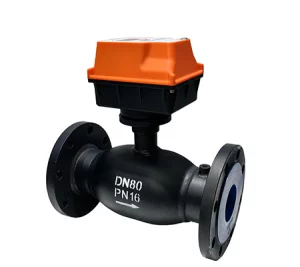Avoid your inquiry is delay response, please enter your WhatsApp/WeChat/Skype along with the message, so we can contact you at the very first time
We will reply you within 24 hours. If for urgent case, please add WhatsApp: +86 13188899036, or WeChat: 0531-87968777. Or call 0531-87968777 directly.
* We respect your confidentiality and all information are protected. We will only use your information to respond to your inquiry and will never send unsolicited emails or promotional messages.
Uneven room temperatures, noisy risers, and wasted pump horsepower plague many buildings. When water races through short loops and starves far coils, comfort drops and energy costs soar. An electric balancing valve restores precise balance, letting every coil receive the right flow—automatically and efficiently.
An electric balancing valve is a smart valve that senses differential pressure and adjusts its orifice to keep the flow rate steady in a hydronic loop. Unlike a manual balancing valve, it re‑balances on load changes, maintaining design gpm without field adjustment. This automatic balancing saves commissioning time, cuts pump energy, and improves comfort in heating and cooling systems.

Carbon steel balance valve
Hydronic balance means that every coil, radiator, and terminal receives its design flow of water. Without balance, short piping paths rob flow from long branches. Rooms over‑heat, others stay cool, pumps work harder, and tenants complain. By keeping pressure differences in check, a balancing valve lets the system deliver heat or cool energy evenly.
Our smart‑valve manufacturing plant has seen this in hundreds of commercial installs. When a new chiller plant starts, technicians often tweak manual valves for hours. An automatic balancing valve solves that workload by self‑adjusting from the first minute of operation.
Inside the brass valve body sits a motorized cartridge, a tiny diaphragm, and a differential‑pressure sensor. The sensor compares upstream and downstream pressure. If flow rises above set gpm, the controller drives the motor to pinch the orifice, reducing flow. If flow falls, it opens in the opposite direction.
| Component | Purpose | Material |
|---|---|---|
| Brass body | Corrosion resistance | Brass / DZR |
| Motor & gear | Adjust orifice | 24 V electric |
| Sensor | Measures ΔP | Composite |
| Control board | Reads pressure, outputs torque | PCB conformal‑coated |
Because the actuator receives a continuous voltage signal (0‑10 V or 24 VDC), a BAS can also control the set flow rate dynamically—ideal for demand‑response programs.
Manual balancing depends on a fixed orifice and hand wheel. Once technicians leave, loads change and the preset is lost. An automatic balancing valve senses real‑time pressure and self‑corrects. The electric variant adds BAS connectivity for trend logs.
| Feature | Manual‑Balancing Valve | Electric Balancing Valve |
|---|---|---|
| Field adjustment | Yes—manual | None after start‑up |
| Response to load | Static | Dynamic |
| BAS feedback | Flow meter only | Built‑in gpm signal |
| Commissioning time | Long | Short |
| Benefit | Low cost | Stable comfort & energy savings |
“Switching from manual balancing to our smart electric models cut commissioning time by 60 %,” says Liu H., senior TAB engineer at a 450‑room hotel retrofit.
Legionella risk rises when branches stagnate. A thermostatic balancing valve maintains 55 °C return temperature, while our electric version fine‑tunes flow to match draw patterns without overheating.
Variable‑speed pumps lower head as valves throttle. Balanced flow ensures every coil delivers rated tons of cooling—even at low ΔT.
Campus loops with 2‑mile piping suffer head fluctuations. Automatic balancing stabilizes pressure at each building connection, preventing cross‑flow.
Because each product range covers multiple sizes (½ – 2 inch) and flows (0.3 – 20 gpm), selection is quick in our web configurator.
Our free software imports BIM pipe layouts, simulates water velocities, and flags branches needing balance. It then auto‑suggests the best electric balancing valve with part number, pressure setting, and Cv.
Method:
• Drag‑and‑drop pump curve.
• Enter coil flow rate requirement.
• The tool plots head vs range, exports schedule to Revit.
This saves design time and eliminates oversizing that can waste pump horsepower.
Because units are easy to install, field labor drops—a big benefit for mechanical contractors.
A balanced system also extends equipment life by preventing cavitation in control valves.
Does the valve handle glycol blends?
Yes, EPDM seals cover –10 °C to +120 °C temperature range.
What if ΔP exceeds sensor capacity?
A built‑in bypass protects the diaphragm; choose the high‑range cartridge.
Is it compatible with Caleffi S.p.A parts?
Thread dimensions follow ISO 228, so you can mix‑and‑match with caleffi s.p.a strainers.
Can I read real‑time gpm?
An optional Hall sensor outputs 0‑10 V proportional to flow rate.
Tomorrow’s buildings will link electric balancing valves to cloud analytics. By learning load patterns, AI will pre‑empt spikes, trim pump speed, and even forecast system maintenance. Our newest model ships with MQTT and BACnet‑IP, ready for edge‑computing gateways.
How often should I commission an automatic balancing valve?
Check once per year; the actuator self‑tests every 24 hours.
Will the motor fail in high humidity?
IP54 gasket and silica gel packs keep electronics dry.
Can I use the valve in a condensate line?
Yes, but ensure pressure stays below the 230 psi rating.
Does the product require upstream straight pipe?
Only 5 pipe diameters, thanks to the internal honeycomb flow straightener.
What sizes are available?
½, ¾, 1, 1¼, 1½, and 2 inch bodies—covering 0.3 – 20 gpm.
Smart‑Valve Manufacturing Plants—delivering robust, customizable flow‑control solutions worldwide.